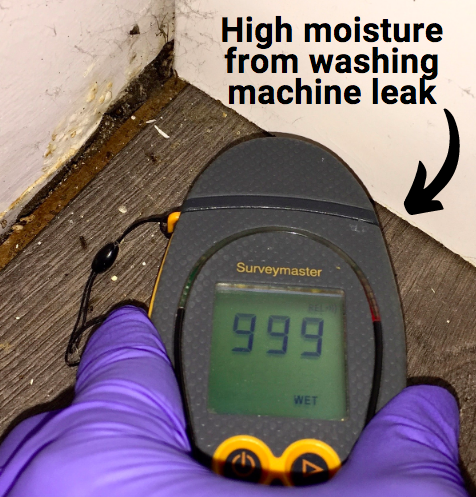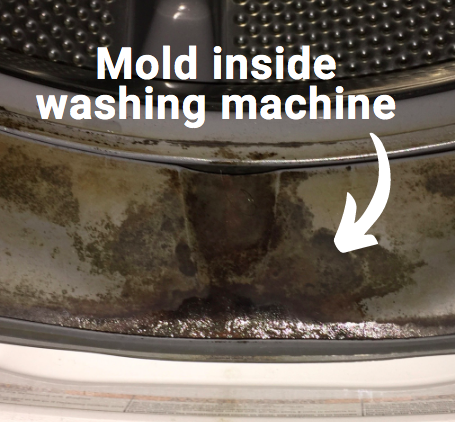Have You Noticed A Musty Smell?
The laundry room is considered a "wet area" where a lot of moisture is generated, so mold is common.
If you have come this far, you will be well aware that mold grows as a result of water, mold food (organic debris), and moderate temperatures.
In condos, a huge number of water damage and mold-related issues have been caused in the laundry room.
Insurance claims will continue to increase in cost for strata properties if people are not motivated to protect each other, by at least trying to prevent these unnecessary leaks or floods.
Whether you are a homeowner or live in a building, you need to recognize how a major mold issue can affect your family and pocketbook.
Mold is serious, and not to be taken lightly!
this chapter explains, in great detail, the most common mold and moisture-related problems that you are likely to encounter from your laundry room.
Main Causes Of Laundry Room Mold
Leak or flood
Without question, the most problematic and expensive cause of serious water damage and mold in the laundry room is from a leak or flood.
The washer hose connections are under constant pressure unless you shut them off after each wash cycle. For most people, this just isn’t going to happen.
Typically, the older rubber washer hoses break down and burst from the constant pressure.

Leaks and floods in the laundry also happen from improper installations. When the washer hoses are too tight or lose a leak is likely. The impact of a flood will depend on how much water there is and how quickly the situation can be resolved.
When there is a small, ongoing leak, signs often go undetected. The washing machine may conceal the leak.
When water penetrates the floor surface, moisture will sit and begin to grow mold just below the surface of the floor.
Unfortunately, people are busy and don't think about looking under or behind the washer/dryer regularly.
In the meantime, the mold quietly goes on about its business until we discover it, as noted in the picture.

Excess humidity in the laundry room
Laundry rooms are warm, humid enclosed areas. Lack of proper ventilation and limited airflow encourages mold growth.
When people leave their wet clothes inside the laundry room or the washing machine, the clothing will eventually smell musty. If the laundry is left too long (more than 24 hours) mold will begin to grow.
EXPERT TIP
If you have a dryer hose vent that is made from a plastic corrugated material, it should be replaced with a rigid metal vent duct for two reasons:
1) The older style corrugated vent hoses trap condensation and dust, which will host mold.
2) Plastic or foil vent hoses are combustible when exposed to high temperatures, posing a fire risk.
Weak or loose dryer connections will cause humidity to condensate along with the ceiling and wall surfaces.
Plastic/corrugated vent hoses contribute to humidity and mold issues, as they collect condensation and dust.
They are weak and easily break down, resulting in lint along the back wall of the laundry room.

Mold growth inside your washing machine
Many people complain about the smell of mold coming from their washing machines. This is especially true with the newer, high-efficiency front-loading machines.
Front-loading washing machines need more maintenance to reduce mold than the traditional top-loading type. Over time, the plastic supply lines inside the machine will accumulate mold.
The new standard machines have an airtight door, gasket, and rubber seal. This prevents the humid air from escaping. The residual debris, soap, and scum will build up in the rubber seal… resulting in smelly mold.
Preventing Laundry Room Mold
Ensure adequate access to the main water shut-off valves
You need to be able to access them quickly to minimize the damage in the event of a leak, so make it possible by moving the machines or by contacting a contractor to create a space from an adjacent room.
Buy a washer pan and place it below the washing machine to contain any accidental leaks. If you fail to do this, you may encounter a nasty surprise like the one discovered in the picture below.
This could save you a lot of money and prevent mold damage. Of course, you’ll want to clean it out every month.
I recommend placing a water alarm in the laundry room. This was also mentioned in the kitchen mold section if you didn't have a chance to read it.
Although not always convenient, it is best to stay home when you run the washing machine to help address a leak or flood in short order, should you notice a leak or flood, etc.
As mentioned above, rubber hoses will eventually leak; so make sure you change the hose connections to steel braided hoses if you currently have rubber hoses installed.

Reduce humidity in laundry room
Proper ventilation is extremely important in a wet area like the laundry room where there is typically excess humidity.
If you do not have a ventilation fan in the laundry room, then use a dehumidifier and reduce the humidity levels to approximately 50% or lower.
Once a load of laundry is done, immediately remove the damp clothes, place them in the dryer and turn it on.
If you do have an exhaust fan, this is the time to turn it on. If you install a new one, consider a moisture-sensing exhaust fan, as recommended in the bathroom section.
I always advise against people drying their damp clothing inside the home on racks. If possible air-dry them outside.
However, for those of you who prefer to dry inside because you don’t want to damage your delicate clothing, and can’t dry them outside… run a dehumidifier in the laundry room alongside a portable space heater. Note – my best advice is to use the dryer.
Another inexpensive way to reduce the humidity is by purchasing moisture-absorbing products. They can be found at your local hardware store or online from a company called DampRid.
You need to be checking the dryer vent connection to limit warm humid air and laundry lint from messing up the back wall behind the dryer. Try your best to keep this area clean and dry to prevent mold.
For those with front-loading washing machines, leave the door open after every wash to allow the machine to air out.
Consider using a product called Affresh in your washing machine. It is designed to prevent mold growth. Just read the instructions and you’re good to go.
Weekly maintenance should include cleaning out and drying the rubber gasket.
I like to use a simple green solution of dish soap, vinegar, and water, mixed in a spray bottle. There are stronger, commercial solutions available at your local hardware store.

Remove and dry out the detergent loading compartments as well.
If you have a high-efficiency machine, stay away from liquid fabric softener as it leaves a mold-hungry residue. While you are at it, buy powder detergent that produces fewer suds.
After every drying cycle, clean the lint trap. The washing machine lint filter should also be cleaned every month or more, depending on how often you do laundry and how large the load size is.
Proper washing machine and dryer maintenance will help prevent laundry room mold. For more information on this, I recommend visiting an appliance store to ask a few questions about the best way to maintain your specific machines.
Thoroughly clean all dust, lint, and dirt
Take a flashlight and look below and behind the washer/dryer every few months.
You will be looking for signs of debris build-up and moisture of course.
Condensation, dirt, and dust can also cause mold on or inside cupboards and cabinets. It is best to clean all surfaces, and regulate the temperature in the laundry room to prevent the mold from coming back.

Congratulations for getting through this chapter!
In the last chapter, we cover mold in bedrooms and common areas throughout the home.


